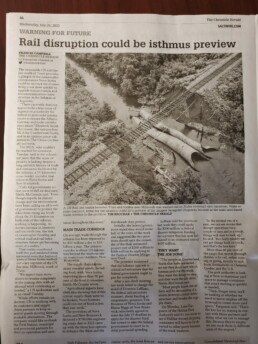Media Release
July 27, 2023
Chamber seeks support from national network to protect vital trade corridor
TRURO- The Truro and Colchester Chamber of Commerce is seeking support from the national Chamber network to protect vital trade infrastructure on the Chignecto Isthmus.
In early June, the Truro Chamber submitted recommendations to the Canadian Chamber of Commerce for federal government action that will be presented to more than 400 chambers across Canada in October to seek the national organization’s endorsement for support.
“Our Chamber, and its supporters across Atlantic Canada, is firm in its position that securing this trade corridor is an absolute priority and government at all levels must immediately put an action plan in place to address it,” said Chamber President Eric Tanton.
The policy position, and its recommendations, has already received an endorsement by the Canadian Chamber of Commerce’s Transportation Policy Committee.
The Isthmus of Chignecto is the narrow, low-lying neck of land spanning approximately 21 km, that provides the only land connection between Nova Scotia and the rest of Canada and the principal transportation connection to Newfoundland and Labrador. The isthmus is composed primarily of marshlands located at the head of the Bay of Fundy.
There are numerous transportation and energy transmission linkages that, if interrupted, would have enormous economic impacts on people and businesses in and outside Atlantic Canada. The Trans-Canada Highway, the Canadian National Rail Line, the High Voltage interconnect, fiber-optical cables, a wind farm and the Maritimes and Northeast Gas Pipeline span this narrow stretch of land.
The Truro-based Chamber is recommending the federal government consider the vulnerabilities in this vital trade corridor a national priority while committing to reliable timelines for project completion. It further asks that they establish an equitable funding model removing the unfair burden of repair cost from the two provinces of Nova Scotia and New Brunswick that reflects the national significance of this corridor on trade and utilities.
The estimated $35 billion per annum value of goods and services through the corridor, inclusive of revenues generated by in-corridor economic activity, is at risk. The origin and destinations of transported goods span well beyond markets in Atlantic Canada, handling goods from across Canada to international markets and the island of Newfoundland.
The key challenge in this area is that flood protection is provided by a system of dykes managed by two provincial government departments and CN Rail. A significant portion of the system relies solely on the existence of a raised rail bed that parallels the Trans-Canada Highway for about 8 km. The balance of the system is provided by very old dykes.
“We recently witnessed the impact intense storms and flooding can have on significant trade corridors with the destruction of a section of CN’s rail line right here in Millbrook First Nation, as well as the damage to main roads including sections of the TransCanada Highway,” said Tanton. “The value of this transportation infrastructure to the national economy is significant and the threat to its operation is real.”
The value of goods transported across the isthmus is estimated at roughly $50M a day and growing. More than 400,000 containers and 230,000 new cars pass through the isthmus on their way to and from the Port of Halifax every year.
The impact of imports and exports to and from the port of Halifax last year is significant in reaching North American Markets. In 2022, 21 per cent of exported goods originated from Midwest US, 39 per cent from Central Canada and 33 per cent from Atlantic Canada, the remaining export markets include Western Canada and other areas of the US. When looking at imports of containerized cargo last year, nearly half of the cargo arriving at the Port of Halifax was sent to markets in Central Canada, about a quarter of it remained in Atlantic Canada and 19 per cent was sent to the Midwest US, the remainder was shipped to western Canada, and other US markets.
A 2022 study costing more than $700,000, cost shared between the federal government and provincial governments of NS and NB, identified 10 potential options, then shortlisted to three with the highest costed option being $300.8 M. That cost is speculated to have increased in the past year. The study indicated a 10-year timeline to put solutions in place. Federal government has indicated it would consider covering up to 50 per of the cost.
“It is not a question of if there will be an extreme weather or tidal event that breaches the dyke system, simply a question of when,” said Tanton.
The study assumes that, if the status quo persists, over the next 30 years there will be an extreme weather event which results in the closure of the Chignecto Isthmus for two days’ duration once every five years. on the annual trade value of $35 billion the 12-day interruption has a total value of $1.2 billion.
To ensure an all-season trade route to PEI, in the past 30 years Ottawa has contributed more than $1.257B, through an annual subsidy to Strait Crossing Development Inc., compensating for the construction of the Confederation Bridge, exclusive of ongoing revenue from tolls. The Chamber believes the federal government should consider the Chignecto Isthmus of equal importance to the country’s trade infrastructure.
-30-
Media Contact:
Sherry Martell
Executive Director
Truro and Colchester Chamber of Commerce
902-895-6328, or 902-890-4616 (cell)
Download Release here:

